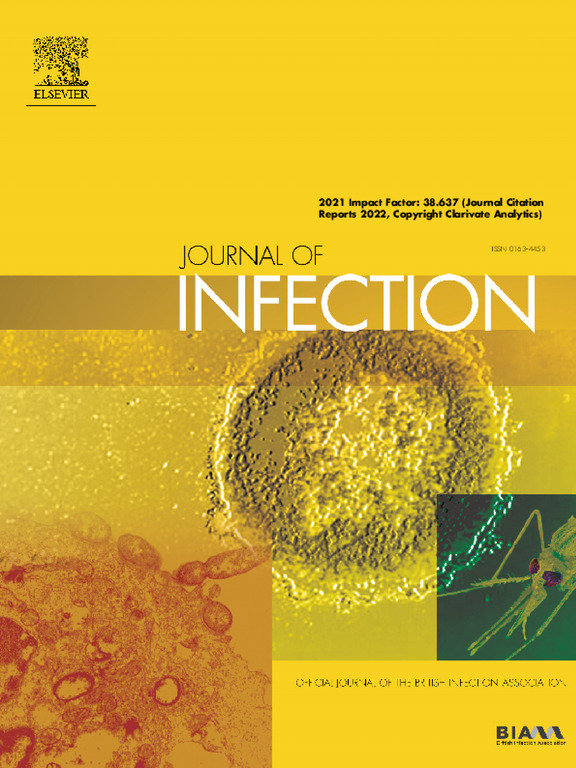儿童复发性侵袭性肺炎球菌病:一项回顾性队列研究,英国,2006/07-2017/18
IF 14.3
1区 医学
Q1 INFECTIOUS DISEASES
引用次数: 0
摘要
背景:复发性侵袭性肺炎球菌病(IPD)在儿童中很少见,通常伴有潜在的合并症。我们的目的是评估复发性IPD儿童在12年期间的风险和特征,包括在英国国家儿童免疫计划中引入7价(PCV7),然后是13价(PCV13)肺炎球菌结合疫苗(PCV)。方法:我们使用英格兰加强的国家监测数据,纳入2006/07-2017/18年期间所有实验室确诊的儿童(15岁)IPD病例。我们评估了复发性IPD的风险和发生率、血清型和人口统计学、合并症状况和患病率、疫苗接种状况、临床表现和结果,将复发性IPD患儿与单次IPD患儿进行比较。研究结果:5033名12岁以上儿童中有5158例IPD发作,其中2.2%(105/4814)的首次IPD存活者至少有一次复发。复发风险随着年龄和时间的增加而降低。在2015/16-2017/18期间,PCV13取代PCV7后5年,IPD复发率为每10万人年229.0 (95% CI 154.8-339.0),所有复发病例均由非PCV13血清型引起。在可获得血清型信息的情况下,25例复发是由于相同的血清型,两次复发之间的中位数(IQR)间隔较短,为88(57-177)天,60例由于不同的血清型,中位数(IQR)间隔为223(125-574)天(p=0.001)。与健康儿童相比(103.0;95%CI 63.1-168.1),任何合并症儿童的复发率每10万人年高10倍(1061.0;95% ci 827.2-1360.9;62/78(79.5%)有合并症,在免疫抑制儿童中几乎高出30倍(2788.5;95%可信区间2029.0 - -3832.2;38/78例(48.7%)免疫抑制)。复发性IPD后30天病死率2.9%(3/105),对照组4.4% (219/4928);p=0.63)。复发性IPD在儿童中很少见,主要发生在有合并症的儿童中,尤其是免疫抑制。高价pcv具有进一步降低儿童IPD复发风险的潜力。本文章由计算机程序翻译,如有差异,请以英文原文为准。
Recurrent invasive pneumococcal disease in children: A retrospective cohort study, England, 2006/07-2017/18
Background
Recurrent invasive pneumococcal disease (IPD) is rare in children and usually associated with underlying comorbidities. We aimed to assess the risk and describe the characteristics of children with recurrent IPD over a 12-year period covering the introduction of the 7-valent (PCV7), followed by the 13-valent (PCV13) pneumococcal conjugate vaccine (PCV) in the national childhood immunisation programme in England.
Methods
We used enhanced national surveillance data for England and included all laboratory-confirmed IPD cases in children (<15 years) during 2006/07–2017/18. We assessed the risk and rate of recurrent IPD, the serotypes responsible and the demographics, comorbidity status and prevalence, vaccination status, clinical presentation and outcomes in children with recurrent IPD compared to those with a single IPD episode.
Findings
There were 5158 IPD episodes reported in 5033 children over 12 years and 2.2% (105/4814) of those surviving their first IPD had at least one recurrence. Recurrence risk decreased with increasing age and over time. During 2015/16–2017/18, five years after PCV13 replaced PCV7, IPD recurrence rate was 229.0 (95% CI 154.8–339.0) per 100,000 person-years, with all recurrent cases caused by non-PCV13 serotypes. Where serotype information was available, recurrence was due to the same serotype in 25 cases, with a shorter median (IQR) interval of 88 (57–177) days between recurrent episodes, and in 60 cases due to different serotypes, with a median (IQR) interval of 223 (125–574) days (p=0.001). Compared to healthy children (103.0; 95%CI 63.1–168.1), recurrence rate per 100,000 person-years was 10 times higher in children with any comorbidity (1061.0; 95% CI 827.2–1360.9; 62/78 [79.5%] with available information had comorbidities), and almost 30 times higher in immunosuppressed children (2788.5; 95%CI 2029.0–3832.2; 38/78 [48.7%] were immunosuppressed). The 30-day case-fatality rate after recurrent IPD was 2.9% (3/105) compared to 4.4% (219/4928; p=0.63) after single-episode IPD.
Interpretation
Recurrent IPD is rare in children and occurs mainly in children with comorbidities, especially immunosuppression. Higher-valent PCVs have the potential to further reduce the risk of recurrent IPD in children.
求助全文
通过发布文献求助,成功后即可免费获取论文全文。
去求助
来源期刊

Journal of Infection
医学-传染病学
CiteScore
45.90
自引率
3.20%
发文量
475
审稿时长
16 days
期刊介绍:
The Journal of Infection publishes original papers on all aspects of infection - clinical, microbiological and epidemiological. The Journal seeks to bring together knowledge from all specialties involved in infection research and clinical practice, and present the best work in the ever-changing field of infection.
Each issue brings you Editorials that describe current or controversial topics of interest, high quality Reviews to keep you in touch with the latest developments in specific fields of interest, an Epidemiology section reporting studies in the hospital and the general community, and a lively correspondence section.
 求助内容:
求助内容: 应助结果提醒方式:
应助结果提醒方式:


